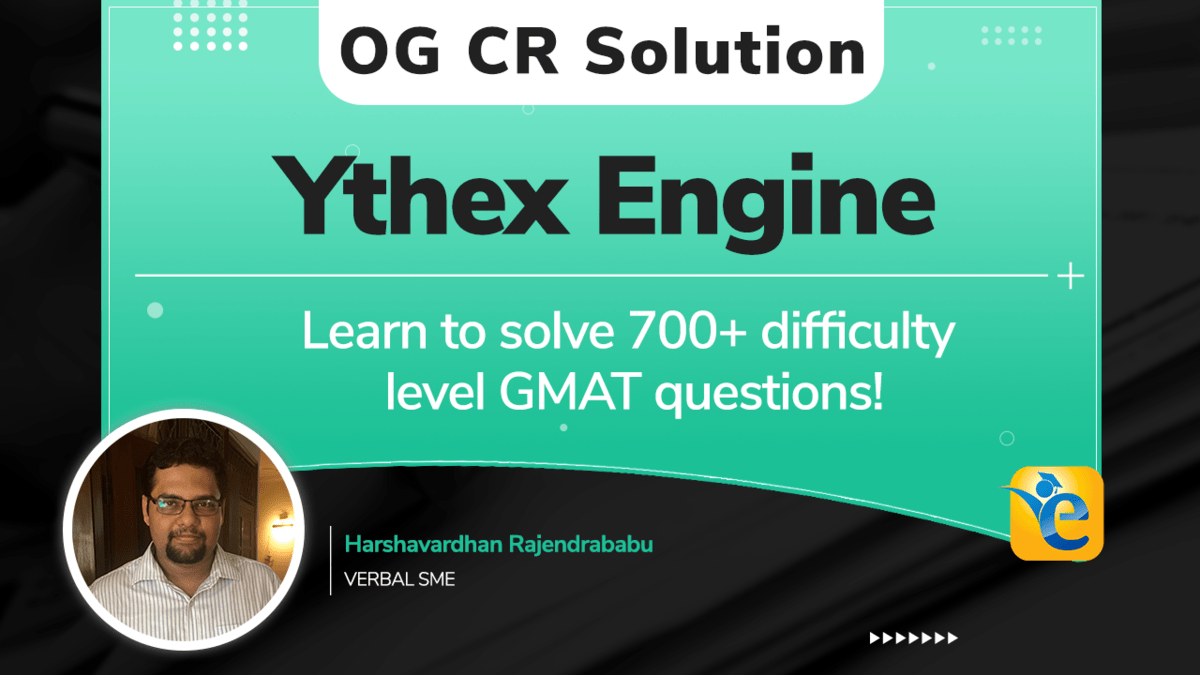In this article, we’ll look at the solution to this Official Guide (OG) question CR75231.01 – “Ythex has developed a small diesel engine…”on critical reasoning.
Ythex has developed a small diesel engine that produces 30 percent less particulate pollution than the engine made by its main rival, Onez, now widely used in Marania; Ythex’s engine is well-suited for use in the thriving warehousing businesses in Marania, although it costs more than the Onez engine. The Maranian government plans to ban within the next two years the use of diesel engines with more than 80 percent of current diesel engine particulate emissions in Marania, and Onez will probably not be able to retool its engine to reduce emissions to reach this target. So if the ban is passed, the Ythex engine ought to sell well in Marania after that time.
Which of the following is an assumption on which the argument above depends?
[Refer to Official Guide for options]
Here is some general information about this OG question:
- PQID: CR75231.01
- Difficulty Level: Medium
- Most Common Incorrect option choice: Choice D
- Question Type: Assumption
OG Video Solution – CR75231.01 – Ythex has developed a small diesel engine…| “Ythex”
Begin your GMAT preparation with the most reviewed GMAT prep company on GMAT club, which has delivered more 700+ scores than any other GMAT club partner. Achieve GMAT 740+ with our AI driven tools that give you personalized feedback at every step of your GMAT journey. Take our free trial today!
OG Solution – CR75231.01 – Ythex has developed a small diesel engine…| “Ythex”
Hey folks! In this article, we are going to study a fascinating CR question from Verbal Review 2020. Although the question is classified as “Medium,” it certainly has some tricky components that have caused confusion among students.
You can also watch this video for this OG solution – Ythex has developed a small diesel engine:
I hope you had fun solving this one (I certainly did!). Now, let us understand what makes this question so interesting:
Subtle meaning trap in the conclusion: For those of you who rejected option E, the real reason may be related to how you visualized the conclusion!
Subtle meaning trap in option D: Option D is, by far, the most popular incorrect answer choice. And there is a reason for this – it conveys a meaning that is almost what we are looking for, but not quite. If one is not careful regarding meaning, it is easy to fall for this option.
Of course, as with all assumption questions, some of the options are just strengtheners that increase our belief in the conclusion but do not satisfy the Must-Be-True (MBT) characteristic of an assumption.
Sidenote: If you want to understand MBT and the negation test better, scroll down to the end of this article for some free resources on the same. We have got you covered!
Now, let us discuss some of the critical aspects of this question.
Visualizing the conclusion
Here is the stated conclusion of the argument:
If the ban is passed, the Ythex engine ought to sell well in Marania after that time.
Notice the bolded portion.
Does the conclusion convey that the Ythex engine will sell well in Marania?
Nope! The conclusion is that the Ythex engine is expected to sell well. Simply put, the author expects the Ythex engine to sell well in Marania if the ban is imposed.
Why does this matter? That is what we are going to see next.
Option E – Why is it the correct answer?
Here is option E:
The other manufacturers of small diesel engines in Marania, if there are any, have not produced an engine as popular and clean-running as Ythex’s new engine.
If you understood the conclusion to mean that the Ythex engine will sell well (even if the ban is passed), then your thought-process was probably something like this:
Negated option E – The other manufacturers of small diesel engines in Marania have produced an engine as popular and clean-running as the Ythex engine.
In other words, in the Maranian market, there are engines from other manufacturers that are just as good and just as popular as the Ythex engine. But the existence of strong competition does not in any way imply that the Ythex engine cannot sell well. Despite the competition, it may very well be that the Ythex engine will sell well. Hence, the conclusion can still hold true even in the presence of the negated option E. So, option E fails the negation test and must be wrong.
Correct?
Nope! And here’s why. As we have seen above, the actual meaning of the conclusion is not that the Ythex engine will sell well, but that the Ythex engine is expected to sell well.
If the ban is passed, the Ythex engine ought to sell well in Marania after that time.
The author makes the above conclusion based on the following logic:
- If the ban is passed, Ythex engines will meet the new criteria (they will not be banned), and these engines are also well suited for some of the thriving businesses in Marania (Warehousing businesses).
- If the ban is passed, even though Onez is widely used in Marania at present and is the main rival of Ythex, its engine will not meet the new criteria and so, will be banned. We are also given that Onez will not be able to retool its engine to meet the new criteria.
Notice how the author’s conclusion about the Ythex engine hinges on the current main competitor, the Onez engine, getting banned because it will not meet the new criteria. In other words, the author’s conclusion that the Ythex engine can be expected to sell well depends on the “lack of strong competition” factor.
Now let’s consider negated option E again.
What if there are other engines (from other manufacturers, not Onez) in the Maranian small diesel engine market that are as popular and as clean-running as the Ythex engine?
This would mean that contrary to what the author expects, the Ythex engine will face strong competition. In such a situation, can the author still expect the Ythex engine to sell well, given that this expectation is based on the premise of a “lack of strong competition”? No.
So, can the author still conclude that the Ythex engine is expected to sell well? No. In other words, the conclusion shatters in the presence of negated option E.
This is why option E is the correct answer.
This is a good example to understand why visualizing the conclusion properly is so, so important!
Option D – A subtle meaning trap
Option D is the most popular incorrect answer choice. Let us figure out why it is incorrect.
The government’s ban on high levels of pollution caused by diesel engines, if passed, will not be difficult to enforce.
We need to be super careful with “difficult to enforce”.
If the ban being “difficult to enforce” means that it cannot get implemented to the degree needed for it to be effective, then yes, the author cannot realistically still expect the Ythex engine to sell well, and so, option D would be correct. Indeed, if Onez engines will still be sold in truckloads in Marania thanks to the ban not being implemented properly, then, even though the ban has been passed, the author cannot expect Ythex engines to sell well.
But here is the problem – “difficult to enforce” does not in any way imply “impossible to enforce properly”.
The ban may indeed be difficult to enforce, but it is still very much possible that it gets implemented properly. The officials in charge of enforcing the ban may have to go through hell to enforce it, but for all we know, they may very well enforce it to the level of 100% – such that not even a single Onez engine will be sold after the ban is passed.
Negation Test: Simply put, option D will fail the negation test. Even if the ban is difficult to enforce, it may be enforced fully and properly to the point that not even a single Onez engine is sold. In such a situation, the Ythex engine can very well be expected to sell well once the ban is passed. In other words, the conclusion can still very much hold true. Hence, option D is incorrect.
A quick note on how to reject the other options
Option A: Marania’s warehousing and transshipment business buys more diesel engines of any size than other types of engines.
This option only suggests that there is a demand for diesel engines in Marania, including small diesel engines, such as the Ythex engine. But this option tells us nothing about why Ythex, in particular, is expected to sell well. So, it is irrelevant to the conclusion.
Option B: Ythex is likely to be able to reduce the cost of its small diesel engine within the next two years.
The author’s logic is not predicated on cost. In fact, the author has already acknowledged that the Ythex engine is costlier than the currently popular Onez engine, and still expects the Ythex engine to sell well. In other words, whether Ythex will be able to reduce the cost of its engine or not is irrelevant; the author expects Ythex to sell well, given its current cost.
Option C: The Maranian government is generally favorable to anti-pollution regulations.
At best, this option only tells us that there is a good chance that the ban gets passed. But this has nothing to do with our conclusion, which is hypothetical (“if the ban is passed”). The conclusion deals with the situation in which the ban gets passed. Whether the ban is likely to get passed is immaterial here.
What are the key takeaways from this question?
- This is actually a lengthy argument. If you are one of those who got bogged down by the sheer length of this question- Slow down. Read each statement slowly, visualize it, and then move on to the next. Don’t read the whole argument in one go without understanding every piece of information.
- Be on the lookout for subtle meaning traps. The difference between “Ythex will sell well” and “Ythex ought to sell well”, or the difference between “difficult to enforce” and “not possible to enforce properly (to the needed level)” – is crucial in solving CR questions correctly.
- Always put extra effort into visualizing the conclusion. Make sure you understand it perfectly in terms of meaning.
Additional Resources
If you want a deeper understanding of the negation test, this article can help you. Also, here is another OG Assumption question in which we are tested on whether we truly visualized the conclusion. You can find our detailed analysis of this question at the top of the thread!
For any other doubts on this question, here is a link to a video solution we created for this question (Traffic Congestion OG CR Question). It should help!
Happy Learning!
Harsha
If you are planning to take the GMAT, we can help you with a personalized study plan and give you access to quality online content to prepare. Write to us at acethegmat@e-gmat.com. We are the most reviewed GMAT prep company on gmatclub with more than 2400 reviews and are the only prep company that has delivered more than 700+ scores than any other GMAT club partner. Why don’t you take a free trial and judge for yourself?











